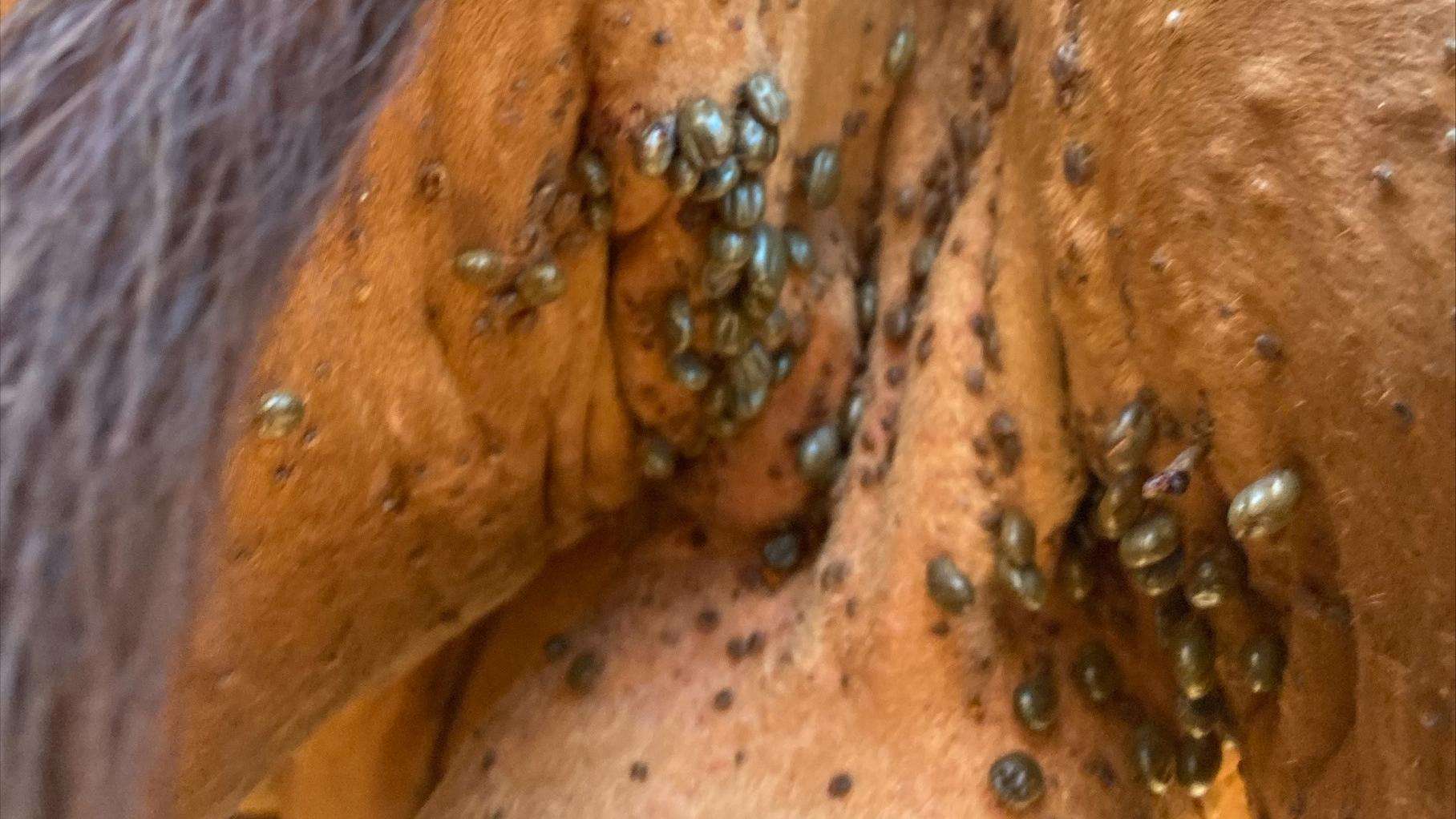Cattle Fever Ticks

Cattle fever ticks (Rhipicephalus (Boophilus) annulatus and R. (B.) microplus) are the most dangerous cattle ectoparasites in the United States. These ticks have been a threat to American agriculture for generations because they spread the disease bovine babesiosis, commonly called cattle fever.
Often fatal, this disease caused enormous losses to the U.S. cattle industry in the late 1800s and early 1900s. Direct and indirect economic losses were estimated at $130.5 million—more than $3 billion today. The disease was eradicated from the United States by 1943, except for a permanent quarantine area along the Texas/Mexico border, where cattle fever ticks are still found.
Cattle fever ticks typically attach themselves to the skin inside an animal's thigh, flanks, and forelegs or along the belly and brisket.
Cattle fever ticks develop through three life stages while on the host animal: larva, nymph, and adult.
Potential hosts of cattle fever ticks include livestock (mainly cattle and horses), white-tailed deer, and exotic hoofstock, such as nilgai antelope and red deer. Cattle fever ticks do not often attach to people.
APHIS or the Texas Animal Health Commission (TAHC) inspects all livestock within the permanent quarantine zone for ticks every year. APHIS or TAHC inspectors also treat, inspect, and certify all cattle as tick-free before they can move out of the quarantine zone to prevent ticks from spreading. In addition, APHIS and TAHC set up temporary quarantines as needed if the ticks are found outside of the permanent quarantine zone.
If you have questions about your livestock and potential tick infestations, call or email APHIS or TAHC:
APHIS Cattle Fever Tick Eradication Program
Email: feverticks@usda.gov
Phone: 956-726-2228
Texas Animal Health Commission
Email: comments@tahc.texas.gov
Phone: 512-719-0700
If your premises is quarantined for cattle fever ticks, Federal and State animal health regulations will require all your livestock, including horses, to be treated. The treatment options vary based on what animals you have and how you plan to use or move the animals. When your premises is quarantined, animal health officials will work with you to develop a herd plan.
View Cattle Fever Tick Eradication Program and Treatment Options brochure (3.55 MB)
Programa de Erradicación de Garrapatas de Fiebre Bovina y opciones de tratamiento
Report Signs of Animal Disease
Producers or owners who suspect an animal disease should contact their veterinarian to evaluate the animal or herd. Find an accredited veterinarian.
Animal health professionals (veterinarians; diagnostic laboratories; public health, zoo, or wildlife personnel; and others) report diagnosed or suspected cases of nationally listed reportable animal diseases to APHIS District Offices and to the State animal health official as applicable under State reporting regulations.
Controlling Cattle Fever Ticks
Today, cattle fever ticks are somewhat confined to a permanent quarantine zone that runs from Brownsville to Del Rio, TX, along the Mexican border. Mexico continues to find babesiosis, so this buffer zone plays an important role in keeping ticks from spreading the disease back into the United States.
Other populations of cattle fever ticks are found in Puerto Rico and the U.S. Virgin Islands. APHIS helps support local programs in those areas.
View the Cattle Fever Tick Research Milestones Brochure
Ver los hitos de la investigación sobre las garrapatas fiebre del ganado
APHIS leads the Cattle Fever Tick Eradication Program, a cooperative effort started with the Texas Animal Health Commission (TAHC) and cattle industry in 1906 to rid the country of cattle fever.
APHIS and TAHC work together to systematically detect, treat, and eradicate cattle fever tick infestations.
- We inspect all livestock within the permanent quarantine zone for ticks every year.
- We also require all cattle to be treated, inspected, and certified as tick-free before they can move out of the quarantine zone.
- If ticks are found outside of the quarantine zone, we set up temporary quarantines as needed. These animals must also be treated and inspected before leaving quarantine.
In addition, APHIS has a cadre of “tick riders" (horse-mounted patrol inspectors) who ride along the Texas/Mexico border. They look for signs of stray or smuggled livestock from Mexico that might carry fever ticks into the United States. Intercepted animals are inspected, treated, and quarantined.
Bovine Anaplasmosis Information Sheet (January 2024)
Bovine Babesiosis Information Sheet (January 2024)
| Title | Documents | Month/Year Published |
|---|---|---|
| Cattle Fever Tick Eradication Program Fence Deterrent in Cameron and Zapata Counties, Texas | Final Environmental Assessment (2.04 MB) Finding of No Significant Impact (316.12 KB) | March 2023 |
| Cattle Fever Tick Eradication Program Fence Deterrent in Cameron and Willacy Counties, Texas | Final Supplemental Environmental Assessment (7.01 MB) Finding of No Significant Impact (for Supplemental EA) (228.88 KB) | April 2022 |
| Final Environmental Assessment (2.68 MB) Finding of No Significant Impact (for Final EA) (124.79 KB) | July 2021 | |
| Cattle Fever Tick Eradication on Laguna Atascosa and Lower Rio Grande Valley National Wildlife Refuges | Final Environmental Assessment (5.81 MB) Finding of No Significant Impact (310.07 KB) | February 2018 |
| Cattle Fever Tick Eradication Program Use of Ivermectin Corn | Final Environmental Assessment (1.62 MB) Finding of No Significant Impact (346.94 KB) | January 2017 |

